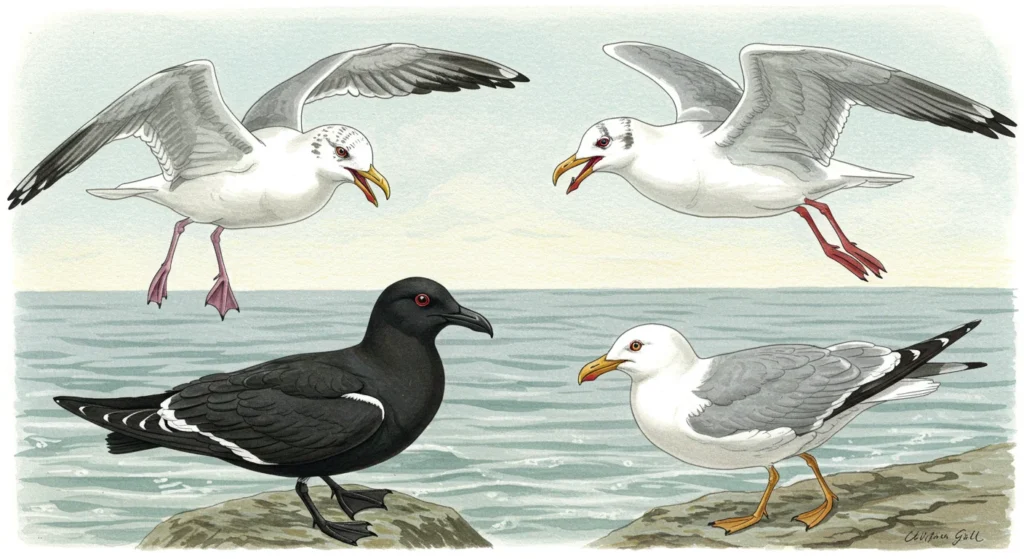Gulls soar over coastlines. Their cries echo through the air. These birds captivate hearts with their grace and resilience. Gull symbolism carries deep meanings across cultures. It reflects freedom, adaptability, and spiritual messages.
Seagulls inhabit diverse environments. Coastal regions are their primary homes. They also thrive in inland lakes and urban areas. Their adaptability allows them to nest on cliffs, beaches, or rooftops. This versatility makes gulls symbols of resilience.
Migration patterns vary by species. Some gulls travel thousands of miles. Others stay in one region. Their ability to navigate vast distances reflects determination. Gulls’ habitats show their ability to find balance in any setting.
This Guide explores the rich symbolism of gulls. It covers their cultural significance, spiritual meanings, and ecological roles. Whether you spot a gull at the beach or dream of one, understanding its symbolism can inspire and guide.
Key Takeaways:
- Gulls symbolize freedom, adaptability, and spiritual guidance.
- Different cultures view gulls as messengers or symbols of resilience.
- Gulls play vital ecological roles in coastal ecosystems.
- Dreams of gulls often signal personal growth or new perspectives.
- Various gull species carry unique symbolic meanings.
Understanding Gull Symbolism – A Broad Perspective:
Gulls are more than beach birds. They are symbolic of freedom, survival, and spiritual connection. Individuals equate gulls with the capacity to overcome life’s adversity. Their flight across great oceans prompts one to think of unlimited possibilities. Gulls are messengers between the material and spiritual realms in many cultures.

“The gull sees farthest who flies highest.” – Richard Bach, Jonathan Livingston Seagull
This quote from Richard Bach highlights the gull’s connection to vision and aspiration. Gulls encourage us to rise above struggles. They remind us to seek new horizons.
Seagulls thrive in harsh environments. For instance, they adapt to storms, scarcity, and changing tides. As a result, this resilience makes them powerful symbols of endurance. Additionally, their ability to glide effortlessly reflects a sense of freedom. In a spiritual context, gulls often represent guidance. Ultimately, they urge us to trust our instincts and embrace change.
Cultural Significance of Gull Symbolism – Traditions and Methodology:
Gulls, often seen soaring over coastlines, carry rich cultural symbolism across traditions, embodying freedom, adaptability, and resilience. In various cultures, these birds are more than mere scavengers; they hold spiritual and symbolic significance, reflecting human connections to the sea, sky, and survival.
Gulls in Native American Cultures:
Native American communities consider gulls to be sacred. Coastal groups, such as the Haida, consider gulls to be messengers. They think gulls take prayers to heaven. Gulls represent the community as well. Their flocks symbolize cooperation and unity. Gulls are often illustrated guiding lost souls to safety.
Seagulls in Celtic Mythology:

Celtic mythology associates gulls with the sea and change. Specifically, they symbolize adaptability and depth of feeling. For example, gulls feature in stories as navigators for sailors. Moreover, their calls indicate warnings or blessings. Thus, gulls were regarded by the Celts as bridges between the land and the sea, ultimately serving as a symbol of balance.
Gulls in Contemporary Literature and Media:
Contemporary tales bring gull symbolism to a higher level. Richard Bach’s Jonathan Livingston Seagull describes gulls as truth seekers. The novel employs gulls to describe self-discovery and liberation. Films and paintings tend to portray gulls as symbols of hope. They bring about nostalgia and tranquility when they appear in coastal scenes.
“You have the freedom to be yourself, your true self, here and now, and nothing can stand in your way.” – Richard Bach
This quote emphasizes the gull’s role as a symbol of individuality. It inspires readers to embrace their unique paths.
Spiritual Meaning – Seagulls as Messengers of Change:
Their flight symbolizes moving forward. Spiritually, gulls encourage letting go of fears. They remind us to trust the journey. Seeing a gull may signal a need for new perspectives.
Symbolism of Movement and Transition:
Life tends to introduce unexpected changes. Seagulls remind us to go with these changes. Their capacity to ride out storms symbolizes resilience. When a seagull shows up, it might compel you to let go of resistance. It inspires trust in the natural flow of life.
Their migratory patterns support this message. Most seagull species migrate long distances. This migration represents individual transformation. Spiritually, it indicates shedding old habits. Seagulls instill bravery to venture into new areas. Their arrival can signal a moment to enter the unknown.
Relation to Emotional and Spiritual Development:
Seagulls tend to show up at emotional turning points. Their screams cut through the silence. This represents shattering stagnation. Spiritually, seagulls urge inner reflection. They ask that unresolved feelings be addressed. Their presence might indicate a need to heal or grow.
This is reflective of our capacity to trust inner wisdom. Having a seagull appear may mean to listen to your instincts. It might be a sign of spiritual awakening. Seagulls prompt aligning with your true purpose.
Seagulls as Omens of Opportunity:
Seagulls are opportunistic feeders. Specifically, they take opportunities for sustenance. In a spiritual sense, this represents openness to new opportunities. Consequently, the presence of a seagull can indicate future opportunities. Moreover, it inspires being prepared to take action. Ultimately, their ability to adapt inspires adaptability in making decisions.
For instance, seeing a seagull in a crisis might indicate that clarity is imminent. It implies having faith in the process of transformation. Seagulls remind us that each change holds promise for growth.
“Consider the birds of the air; they do not sow or reap or store away in barns, and yet your heavenly Father feeds them.” – Matthew 6:26 (Bible)
This biblical phrase connects gulls to divine care. It suggests trust in life’s provision.
More For You: 10 Hawks in Pennsylvania (With Pictures & Habitats)!
5 Types of Seagulls – Their Symbolic Meanings:

Herring Gull:
Scientific Name: Larus argentatus
Life Span: Up to 30 years
Size: 22–26 inches
Weight: 1.8–2.8 pounds
Wingspan: 53–57 inches
Status: Least Concern
Diet: Fish, insects, human food scraps
Behavior: Social, opportunistic feeders
Habitat: Coasts, inland lakes, urban areas
Herring gulls are ubiquitous along coastlines. Their forward nature represents boldness. The herring gulls adjust to cities and wild habitats. The adjustment represents capability for survival in any environment. In a spiritual context, herring gulls invoke boldness. They inspire people to grab chances.
Their white and gray feathers are unique. They represent purity and balance. Herring gulls tend to flock together. This action illustrates community strength. Their persistent calling echoes determination. Meeting a herring gull might motivate you to speak truth.
Ring-Billed Gull:
Scientific Name: Larus delawarensis
Life Span: Up to 20 years
Size: 17–21 inches
Weight: 0.7–1.5 pounds
Wingspan: 41–46 inches
Status: Least Concern
Diet: Fish, grains, insects
Behavior: Gregarious, migratory
Habitat: Lakes, rivers, coastal regions
Ring-billed gulls are smaller but spirited. Their black ringed beaks symbolize clarity. These gulls migrate long distances. Their journeys reflect perseverance. Spiritually, ring-billed gulls encourage exploration. They urge you to embrace new paths.
Their adaptability shines in varied habitats. They thrive near water or in fields. This flexibility symbolizes openness to change. Ring-billed gulls often feed in groups. Their teamwork highlights collaboration. Seeing one may prompt you to connect with others.
More For You: 17 Types of Hawks in Texas (With Features & Photos)!
Great Black-Backed Gull:
Scientific Name: Larus marinus
Life Span: Up to 27 years
Size: 28–31 inches
Weight: 2.9–4.4 pounds
Wingspan: 57–63 inches
Status: Least Concern
Diet: Fish, small birds, carrion
Behavior: Solitary, aggressive feeders
Habitat: Rocky coasts, islands
Great black-backed gulls are the largest. Their size represents strength. These gulls take over the feeding grounds. Their boldness speaks of leadership. Spiritually, they urge standing tall. They remind us to take our space.
Their black wings oppose white bodies. This opposition is representative of balance. Great black-backed gulls like to be alone. Their solitary nature shows self-sufficiency. Being confronted by one could mean the need for inner strength.
California Gull:
Scientific Name: Larus californicus
Life Span: Up to 24 years
Size: 20–23 inches
Weight: 1.1–2.2 pounds
Wingspan: 49–55 inches
Status: Least Concern
Diet: Insects, fish, grains
Behavior: Social, migratory
Habitat: Inland lakes, coasts, farmlands
California gulls are versatile travelers. Their migratory nature symbolizes exploration. These gulls thrive in both inland and coastal areas. Their adaptability reflects a willingness to embrace change. Spiritually, California gulls inspire curiosity. They encourage seeking new experiences.
Their mottled plumage blends with the surroundings. This symbolizes humility and grounding. California gulls form tight-knit colonies. Their social bonds highlight loyalty. Spotting a California gull may urge you to nurture relationships.
Black-Headed Gull:
Scientific Name: Chroicocephalus ridibundus
Life Span: Up to 18 years
Size: 14–16 inches
Weight: 0.4–0.9 pounds
Wingspan: 34–39 inches
Status: Least Concern
Diet: Insects, small fish, seeds
Behavior: Agile, vocal
Habitat: Wetlands, coasts, urban areas
Black-headed gulls are small but colorful. For instance, their dark summer hoods are a symbol of wisdom. Moreover, these gulls are active, and their agility is a reflection of mental acuity. Thus, black-headed gulls spiritually urge sharp thinking. In essence, they remind one to remain awake.
Their playful actions are exceptional. They will chase one another when running. This is a sign of spontaneity and joy. Black-headed gulls are adaptable to urban environments. Their adaptability generates innovative problem-solving. Having seen one will get the ideas flowing.
“The gull’s flight is a dance with the wind, a reminder to flow with life’s rhythms.” – Anonymous
This quote captures the gull’s grace. It inspires us to move with life’s changes.
SeaGull Symbolism in Dreams and Omens:
From Native American lore to maritime folklore, gulls appear as messengers, guides, and omens. Consequently, exploring their symbolism reveals how societies interpret their behaviors and environments through unique cultural lenses.
Symbolism in Dreams:
Dreams of gulls tend to convey personal messages, often tied to the dreamer’s emotional or spiritual state. For instance, a flying gull typically indicates freedom or ambition, symbolizing a desire to break free from constraints. Conversely, a grounded gull may suggest feelings of being trapped or restricted.
Moreover, gulls in dreams frequently signal impending change, encouraging the dreamer to embrace new opportunities. Recurring dreams of gulls, in particular, point to spiritual development. These dreams often prompt individuals to listen to their intuition and reflect on their inner growth.
Therefore, recording dream details in a journal can help uncover underlying meanings, as patterns may emerge over time. Ultimately, gulls in dreams encourage introspection and a deeper connection to one’s subconscious.
Seagulls as Omens:
Across cultures, gulls are frequently regarded as omens, their presence imbued with meaning. For example, when a gull soars overhead, it is often interpreted as a sign of good fortune or protection. On the other hand, a gull’s cry might foretell change, such as an approaching storm or a shift in circumstances. However, interpretations vary widely across traditions. In some cultures, gulls are seen as guardians, watching over seafarers or guiding lost souls. In contrast, others view them as storm-bringers, heralding turbulent times.
Interpreting Gull Encounters:
Encounters with gulls in waking life can also carry significant meaning. Their appearance often feels purposeful, as if delivering a message. For this reason, listening to one’s intuition during such moments can provide clarity. Accordingly, following your gut instincts and reflecting on the context of the encounter can help decipher the personal or spiritual insight the gull may represent.
FAQs:
What is the seagull a metaphor for?
Seagulls symbolize personal development and discovery. Their soaring represents transcending restrictions, and their ability to adapt represents accepting transformation.
What is the meaning of the gull bird?
The gull bird represents perseverance, communalism, and divine relationship. It represents the power to live in different conditions and acts as a hope messenger.
What do seagulls mean?
Seagulls symbolize change, opportunity, or spiritual growth. Being around them may mean trusting intuition, adjusting to new situations, or embracing new ideas.
Final Thoughts:
Gull symbolism offers profound lessons. These birds teach resilience, freedom, and spiritual connection. Their adaptability inspires us to navigate life’s challenges.
Their flight encourages new perspectives. Whether in dreams or nature, gulls carry messages of hope. Embrace their wisdom. Let their symbolism guide your journey.
